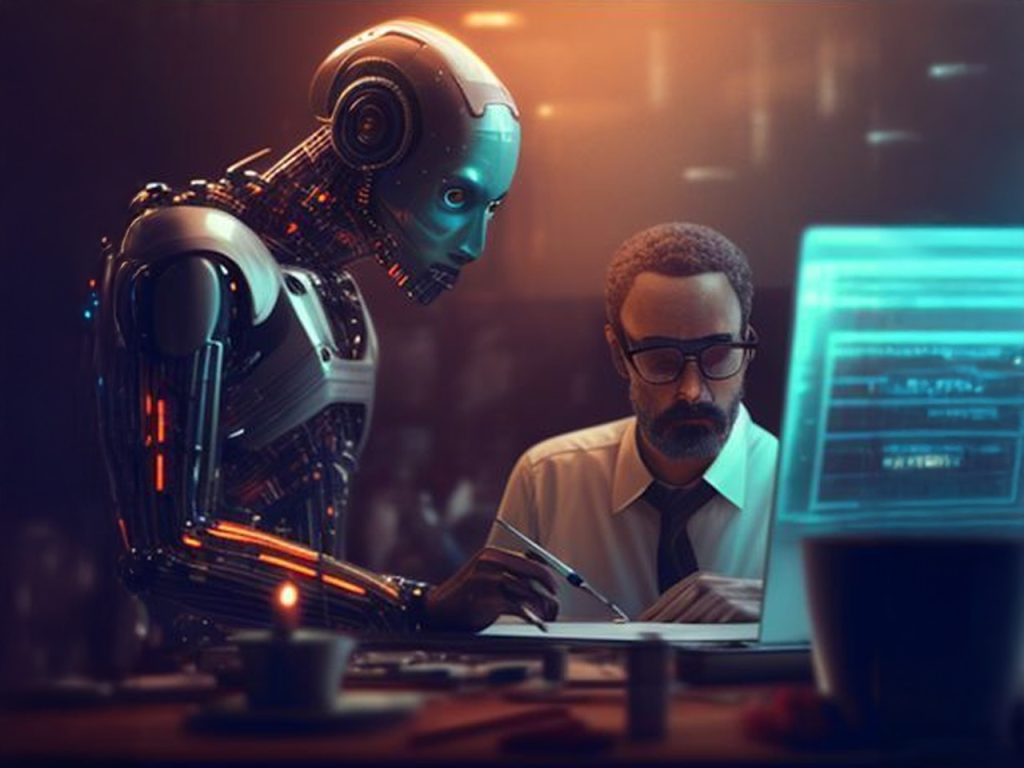Introduction
In the fast-paced digital world, the landscape of user experience (UX) design is constantly evolving. With the rise of artificial intelligence (AI) technologies, some skeptics question whether UX design is heading towards obsolescence. However, in reality, the future of UX design in the age of AI is not the end, but a transformation.
In the future, as AI further develops, it can become helpful in the impact and development of the UX design. Through various AI technologies, designers are thus able to minimize key activities in the design process, gain valuable information and enhance the user experience. This evolution allows a new type of UX design which will eventually be more personalized and based on a deep understanding of user needs. Even if carried out by AI, a complete UX design overhaul is a given, but the human factor simply cannot be dismissed. The goal of UX design, at its core, is to focus on people’s behaviour, feelings and desires. It is clear that designers will remain involved in AI by lending their input on how analytical insights are communicated into interfaces.
In this article, let us introduce readers to the world of UX design post-AI where the challenges and the possibilities are yet to be unveiled. If you are a UX designer experienced in the field or one who wants to know about the effects of AI on this aspect of design, you are sure to benefit from reading this article. We need to consider the future where art and artificial intelligence are concreted together to create unique user experiences.
The Impact of AI on UX Design
As much as it is undeniable that AI is revolutionizing and advancing almost every industry it comes across, those working within the field of UX Design should also consider the following. The use of AI technologies has continued to evolve at a very fast pace and this has influenced the paradigms of UX design. Advancements in the nature and capabilities of AI technologies suggest that they would indeed alter the paradigm employed by designers. Perhaps, one of the most significant impacts of AI on UI design is the use of technology to automate processes involved in the creation of new designs. AI solutions can include tasks like user research, data analysis, and prototyping, so designers themselves can work exclusively on the search for unique creative approaches in design.
Furthermore, the algorithmic computing promotes a deeper understanding of the users’ behaviors and preferences required for the design of effective interfaces. One of the primary capabilities of AI is that using big data, it has the ability to analyze the data obtained, learn from a user, and provide a design solution that can address a specific user’s needs and expectations. Such strategies in UX design result in making of experiences that are more focused on the goals and preferences of the user. Moreover, AI is changing the choice of how designers interact with each other and with their environment. A smart and interactive chatbot or voice-based virtual assistant can then interact with the user, answer his/her questions and can also help in real time feedback which in turn also helps in the betterment of the user experience. AI tools can also enhance design collaboration of the teams so that they can easily share concept, feedback and tweak on work done simultaneously.
Current Trends in AI and UX Design
As IT and UX design are becoming intertwined, some important trends emerge as the future of the interconnection of these two fields develops. Conversational interfaces are one of the most notable trends – with the AI-supported chatbots and virtual assistants being more and more involved in the process of users’ communication. These conversational interfaces not only make the interfaces much more user-friendly but also provide data to designers that can help in further improvements.
The fourth trend is that generative design using AI is now possible where the algorithm can generate design solutions with reference to the user’s preferences and limitations. This approach allows The role of artificial intelligence in UX design. In this research, it looks into the effects of AI to the user experience design where it is seen to have drastically affected. As the evolution of AI technologies offers more opportunities, more opportunities are opened to designers to create user interfaces and experiences.
The prominent manifestation of AI in UX design is by taking over routine aspects of interaction design. AI applications are now available to help designers wireframe, prototype, and even run tests on the outcomes. These kinds of repetitive, time-consuming activities can be effectively replaced by tools so that designers get more time to think and innovate, thus enhancing the overall value of design solutions.
Moreover, designs developers are now relying on AI technologies such as; data analytics and insights to improve how designers approach and meet user expectations. It is possible to develop AI-powered tools to gather and analyze data on the users to help designers understand the users better and their actions, choices, and issues they face when using different products. The use of data also offers the advantage of better decision making since designers can use the data to improve the overall user experience and develop a program that is tailored to users’ needs while also improving the user experience over time.
AI Today & Tomorrow: State & Future of AI & UXD
Analyzing what has been done in the space of integrating AI and UX design, there are several trends emerging that will define the future of the industry. The most remarkable tendency of development is the shift from traditional interfaces to conversational ones, like chatbots and voice assistants. These kinds of AI interfaces are enabling users to engage with digital goods and services in a fluid conversational style eradicating the conventional human and technological interface barriers.
Another trend is that the world is shifting towards the AI-based personalization of all forms of products and services. Machine learning embodies the use of data of the user, which can be used by designers to personalize solutions according to the user’s needs and preferences. Besides, user satisfaction is highly improved at this level of personalization, and as an added bonus, its a key factor in englining user loyalty.
Also, AI + AR/VR are shaping new forms of experience designing, which gives UX new horizons. Spatial computing and computer vision are some of the ultimate tools relevant in design, promoted by artificial intelligence to generate compelling and engaging sense-and-response environments that erase the boundary separating physical reality from virtual fantasy. This is the reason why more and more advanced technologies are being developed to support the application for a more intuitive interaction with the user.
Challenges & Opportunities in the Future of UX Design
However, just like any other forms of implementing AI and UX design, it also comes with its fair share of problems. Another is the complete replacement of the human designers by AI and thereby stripping the designs a human aspect that is critical in developing the best Usability.
Nonetheless, the set reality is that AI is not a tool that is designed to take the place of humans in the design industry; it is designed to support and come alongside human designers. Whether through relieving designers of the tedium of those processes or by offering insights that improve their decision-making, which is what the best AI systems should do, incorporating AI into the design process is a clear way to produce the best user experiences possible.
Another concern is in realizing that designers themselves have to acquire new skills and gain new experiences in order to work effectively when incorporating artificial intelligence into their processes. This means that the core competencies of UX designers like data analysis, machine learning or even using AI in prototyping will become essential skills for the designers in the industry. This will mean embracing education and training as a lifelong process and becoming more committed to individual employee development.
Role of UX Designers in an AI-Driven World
Even as decision making is increasingly being left to AI, the position of the UX designers has not become redundant in the age of enhanced artificial intelligence. AI does offer a prediction and recommendation, which can be a huge help in a designer’s projects, and yet it is the human designer who has to make a decision, to decide how to transform these predictions and recommendations and make them appealing to the users.
This is especially so given the fact that UX designers will continue to embrace the mandate of comprehending human conduct, feelings, and requirements and applying such insights in the design process. They will need to make sure that technologies enabled by artificial intelligence are only for improving the user experience and not the other way round.
Also, UX designers will play a significant role in the integration of AI solutions with human-oriented functional requirements and technological constraints. The designers will collaborate with AI specialists and programmers to understand how the application or website should behave and how can the AI help the user in achieving his or her objective step-by-step while also providing an impressively engaging experience.
Strategies for Incorporating AI into UX design
When UX designers will face the challenges of the next level of the field’s evolution in the ongoing AI advancements, they will have to find the ways to integrate the AI-based technologies into the methodology of the design successfully. Another strategy that is likely to be employed involves ensuring that design is driven by data and analysis through AI tools to improve design performance in the future.
Another approach worth pursuing is to consider the potential of implementing AI-based prototyping and testing environments. These tools can allow designers to go through multiple variations, to assess assumptions, and to collect feedback from the audiences much faster and cheaper. By integrating this aspect of AI into design work, it becomes possible to improve the process of creating new products and services and make them better meet the needs of the users.
Furthermore, UX designers should try to get in touch with AI professionals and coders, which is why interdisciplinary work is so crucial. Cooperation between the two fields enables a designer to incorporate AI features and functions into a design-making process and guarantee that the resulting experience of interacting with a designed product is fluent and engaging.
Ethical Considerations in AI-driven UX Design
While it is still early days and the integration between AI and UX design grows stronger, it is necessary that designers take into consideration the ethical aspects involved in the process. Section one: It is deemed that AI technologies can reinforce and even escalate social paradigms of biasness or unfairness.
Any attendant AI-based or machine-learning experiences must be made wholesome and standard for all users regardless of demographic and other differences and the UX designer has to be careful about the data set that is used to feed these models. It may mean that ethicists, policymakers, and other marginalized groups have to sit with designers and analyze all possible ethical issues that may appear in the product.
Another ethical conflict is the privacy and security of data as reported in the article. This is particularly important because, as current technologies are AI-powered and analyze user data, designers are to guarantee this data is collected and processed ethically, legally, and with people’s informed consent and their personal data protected. There are also issues such as controlling the results or steering users into doing something that designers should be aware of AI tentacles While designing experiences that will be AI backed, designers should ensure that user experiences enslave the users or even swindle them.
UX Design Potential Evolution in the Future
As the integration of AI and UX design continues to evolve, the future of the field holds immense potential for transformation and innovation. One possible trajectory is the emergence of AI-powered design assistants that can help designers ideate, prototype, and iterate on ideas more efficiently and effectively.
These AI-powered design assistants could leverage natural language processing, computer vision, and generative AI to assist designers in tasks such as wireframing, mood boarding, and color palette selection. By automating these repetitive tasks, designers can focus more on the strategic and creative aspects of their work, ultimately leading to more innovative and user-centric designs.
Another potential evolution is the rise of AI-driven personalization, where user experiences are dynamically tailored to the unique needs and preferences of each individual user. This level of personalization could extend beyond the digital realm, with AI-powered IoT devices and smart environments seamlessly adapting to user behavior and preferences in real-time.
Upskilling for UX Designers in the Age of AI
As the UX design field continues to evolve in the age of AI, it is essential for designers to continuously upskill and adapt their skillset to meet the changing demands of the industry. One key area of focus should be developing a deeper understanding of AI technologies, including machine learning, natural language processing, and computer vision.
By gaining a solid grasp of these technical concepts, UX designers can better collaborate with AI experts and developers, ensuring that the integration of AI-powered features and functionalities is seamless and user-centric. Additionally, designers should seek to develop data analysis and visualization skills, as the ability to interpret and communicate AI-driven insights will be crucial in the design decision-making process.
Furthermore, UX designers should cultivate their strategic thinking and problem-solving abilities, as they will be tasked with navigating the complex ethical and practical implications of AI-driven design. This may involve exploring areas such as human-centered design, design ethics, and design thinking, in order to create experiences that are not only technologically advanced but also align with the values and needs of users.
Conclusion
The future of UX design in the age of AI is not one of obsolescence, but rather one of transformation and opportunity. While AI-powered technologies have the potential to disrupt and reshape the design industry, they also present designers with a wealth of new tools and capabilities that can enhance the user experience in unprecedented ways.
By embracing the integration of AI and UX design, designers can leverage the power of data-driven insights, personalization, and automation to create more intuitive, engaging, and user-centric experiences. At the same time, they must remain vigilant in addressing the ethical considerations and potential pitfalls of AI-driven design, ensuring that the user remains at the heart of the design process.
As the future of UX design continues to evolve, designers must be prepared to adapt, upskill, and collaborate with a diverse range of stakeholders, from AI experts to ethicists and policymakers. By doing so, they can help shape a future where AI and human creativity converge to deliver exceptional user experiences that transform the way we interact with technology and the world around us.




